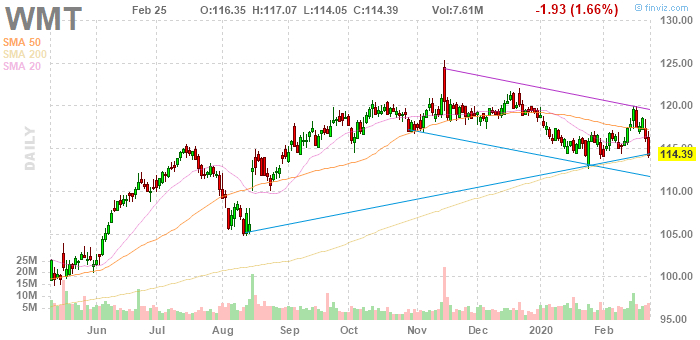Tuesday was another awful day for U.S. equities. The S&P 500 tacked on a 3.03% drop to Monday’s 3.35% decline. As was the case on Monday, every single one of the 30 Dow Jones components closed in the red. McDonald’s (NYSE:MCD), whose shares fell 0.67%, was the index’s best performer.
Wednesday’s big stock charts focus on three Dow stocks. All three have seen the same selling that has dominated the index, and the market, in the last two sessions. Each has hopes for a bounce — both technically and fundamentally, albeit for different reasons.
In markets like this, technical analysis isn’t perfect: it’s tough to find a pattern during such a steep sell-off. But the hope in looking at these quality names is that their charts, and their outlook, might give investors some help in trying to figure out where U.S. stocks head for the rest of the week and beyond.
Walmart (WMT)
There’s a lot going on in the first of Wednesday’s big stock charts. But at the least, it does seem like it could be worse for Walmart (NYSE:WMT):
- WMT stock sits at a key level. Tuesday’s decline sent the stock back toward support that has held on a few occasions so far this year. There’s a narrowing wedge as well, though trading going back to November looks more like a downtrend. It seems too optimistic for WMT to see a quick, sharp reversal out of that uptrend, so stabilizing might be the best investors can hope for right now.
- Of course, even in this market, Walmart stock probably should hold up. The company does have some sensitivity to U.S. macroeconomic trends, but also benefits somewhat when investors trade down. Comparable sales for the namesake chain did decline 0.7% in fiscal 2010 (ending January) and 1.5% the following year. But Walmart wasn’t exactly operating on all cylinders at the time. Its current omnichannel efforts offer a top-line driver that simply didn’t exist a decade ago.
- And so WMT stock might be one for investors to watch closely. If its shares tumble, that might mean that there’s more to this sell-off than just coronavirus fears. A decline here would imply that investors are increasingly pricing in a recession that makes it to our shores. But if WMT can find a bottom — and there’s some hope that it will — other quality names have some hope.
Boeing (BA)
As the second of our big stock charts shows, Boeing (NYSE:BA) finally has given way. BA stock on Tuesday posted its lowest close in over a year. It remains to be seen whether this pullback makes the stock is cheap enough for investors to step in:
- BA stock has established a narrowing descending wedge which often presages a bullish reversal. But as a wide as the wedge is, and as steep as the sell-off has been, it does seem too early to bet on a bounce. Shares have fallen almost 10% just in the last three sessions, and on reasonably heavy volume. And taking a broader view, there’s been a steady pattern of lower highs and lower lows going back to last summer.
- Of course, the irony is that Boeing stock has been dealing with potentially short-term worries for much more than the last sessions. 737 MAX issues now have hovered over the stock for close to a year. Bulls have argued that the company was simply “too big to fail,” and that its duopoly with Airbus (OTCMKTS:EADSY) left airlines with no other option to serve rising travel demand. That thesis, taking the long view, should persist.
- Boeing looks like an intriguing barometer for the market, but in a different way from WMT. While Walmart stock might show when investors are willing to tiptoe back into U.S. stocks, Boeing stock should show when those investors are willing to look past near-term worries. Given that investors already were giving up on Boeing stock when broad markets were rallying, however, it could be a long time before the BA dip gets bought. The stock suggests that will be the case.
UnitedHealth (UNH)
UnitedHealth Group (NYSE:UNH) has been one of the index’s worst stocks over the last two days. The third of Wednesday’s big stock charts shows that needs to change:
- The technical picture looks worrisome. UNH stock has made a textbook bearish reversal out of an ascending narrowing wedge. It has breached the key level of $270. A test of the 200-day moving average looms — and UNH needs to pass that test.
- That may be a lot to ask for. UnitedHealth shares probably are being hit from two directions. Costs could rise if a pandemic does hit the U.S. Meanwhile, building momentum behind Senator Bernie Sanders’ presidential campaign adds a layer of political risk. Cigna (NYSE:CI) and Humana (NYSE:HUM) both fell over 4% on Tuesday as well. It’s worth noting in that context that trading during this sell-off has been very heavy, with UNH seeing its two highest-volume days since November.
- One problem for UnitedHealth stock, then, might be that a normalized broad market doesn’t necessarily mean the end of selling pressure. If political risk is a problem, as appears to be case, UNH could have a lid on it until at least November.
Vince Martin has covered the financial industry for close to a decade for InvestorPlace.com and other outlets. He has no positions in any securities mentioned.



